- There are no more items in your cart
- Shipping Calculated at checkout
-
Sub-Total (inc. VAT)
£0.00
Need Help?
Solar Reflective Paints
Solar reflective paints, also known as cool roof coatings or heat reflective paints, are advanced coatings engineered to reflect a higher amount of sunlight and absorb less heat compared to traditional roofing materials. This innovative technology offers a plethora of benefits, ranging from extending the lifespan of roofs to significant energy savings and enhanced indoor comfort. The demand for energy-efficient and sustainable building solutions is increasing globally, and solar reflective paints are at the forefront of this movement. Below, we discuss the various aspects of solar reflective paints, including their benefits, applications, storage, and application methods. We will also cover common misconceptions, provide technical FAQs, and offer insights into their historical development. Click here for more info.
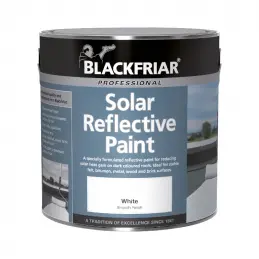
Blackfriar Professional Solar Reflective Paint White
Blackfriar Professional White Solar Reflective Paint is a specially formulated reflective acrylic coating for reducing solar heat gain on tiles, felt, asphalt, wood, masonry and concrete surfaces. Reflective, textured finish Waterproofs and protects Flexible - allows for contraction and expansion Resists surface fungal growth Easy to...
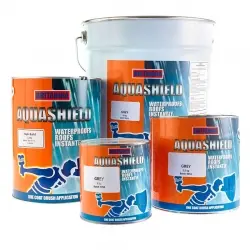
Britannia Aquashield High Build
A solvent-based, instantly waterproofing coating for exterior pitched or flat roofs, bitumen, asbestos cladding, metal, fibreglass roofs and more. Contains added fibres that interlace to cover up small gaps or cracks in the substrate. Rainfall immediately after application has no adverse effect Can be applied by brush or roller
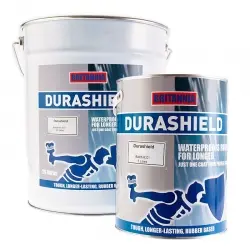
Britannia Durashield
A smooth, cold applied rubber-based waterproofing flat and pitched roof system for a longer lasting seamless coating - a ten year life expectancy with just one coat over surfaces. Rainfall immediately after application has no adverse effect No primer (except on porous/friable surfaces) Reduced labour costs Flexible elastomeric system...
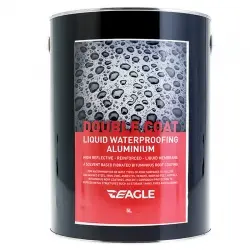
Eagle DoubleCoat Pro-Reflect Liquid Waterproofing
A liquid elastomeric waterproofing membrane reinforced with microfibers and high aluminium content, for waterproofing of most types of roof surfaces and exposed metal structures. Highly recommended for industrial units and warehouses. For most roofs: Galvanised steel Iron zinc Asbestos Cement Roofing felt Asphalt Bituminous...
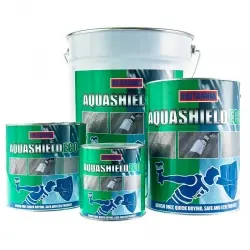
Britannia Aquashield Eco
An acrylic, water-based, highly elastic coating for use on flat roofs, pitched roofs, weathered asphalt and bituminous surfaces, gutters, concrete, brickwork, GRP and fibreglass, felt and metal. Solvent free Dries to form durable and water-resistant finish Particularly suitable for general maintenance work Eco friendly formula...

Coo-Var Solar Reflective Paint Aluminium
Aluminium solar-reflective paint. Reduces heat build-up by deflecting sunlight. For stable felt, concrete, wood, and brick surfaces, primarily for roofs. High-reflective sheen finish.
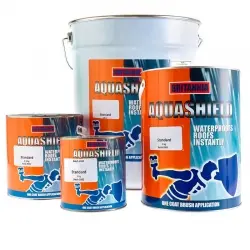
Britannia Aquashield Standard
A ready to use, instantly waterproofing solvent-based coat for exterior pitched or flat roofs, bitumen, metal o fibreglass roofs, asbestos cladding and more. Contains added fibres that interlace to cover up small gaps or cracks in the substrate. Rainfall immediately after application has no adverse effect Can be applied by brush or...
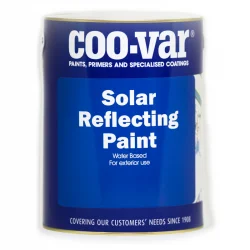
Coo-Var Solar Reflective Paint White
White acrylic solar-reflecting paint designed to reduce heat build-up. For concrete, stable felt, wood, and brick surfaces, primarily on roofs. VOC content under 140g/l, Offers strong protection from sunlight.
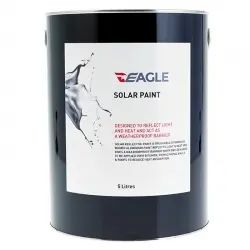
Eagle Aluminium Paint
Eagle Aluminium Paint, a topcoat for bitumen coatings and substrates that provides protection against solar degradation and heat gain with a solar-reflective finish. Dry in approx. 1 hour For use on: Bituminous coatings Aged asphalt Primed steel Apply by brush or mohair roller Requires just 2 coats More Information Delivery...
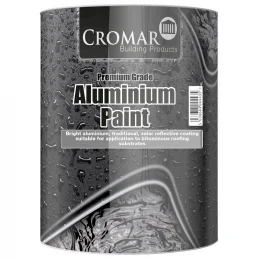
Cromar Aluminium Paint (Contractor Grade)
Cromar Aluminium Paint (Contractor Grade), an economy version of Aluminium Paint ‐ a bright aluminium, traditional, solar reflective coating suitable for application to bituminous roofing substrates. Ideal for protection against sun and weathering of roofs Covers approximately 5 - 10m² per litre per coat, depending upon the surface Dries...
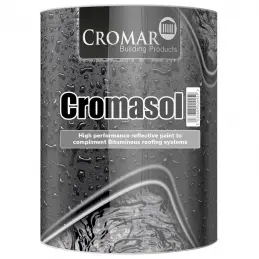
Cromar Cromasol Solar Reflective Paint
Cromar Cromasol is a superior, alcohol based, solar reflective coating and when applied to a variety of roofing substrates, provides lasting protection against UV degradation and solar gain. High performance Compliments Bituminous roofing systems Ready to use Prevents softening of asphalt Suitable for use on roofs susceptible to ponding...
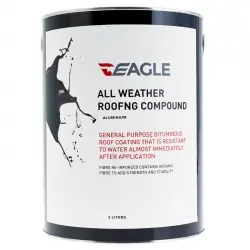
Eagle All Weather Roof Coat Aluminium
Use Eagle All Weather Roof Coat Aluminium on top of All Weather Roofing Compound for a tough and flexible solar reflective coating on roofs, sheeting, slates and tiles. The final coat in multi-coat systems Use with All Weather Roofing Compound for waterproofing and solar resistance Heavily bodied with fillers, fibres, and a high grade of...
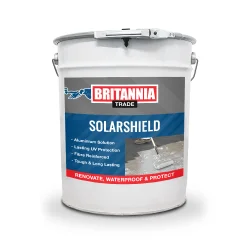
Britannia Solarshield
Britannia Solarshield is an aluminium modified bitumen solution that works as both an additional waterproof protective layer for bituminous systems and a life extender to the overall system by way of enhanced UV protection. Solar and weather protective coating for bituminous roofing systems Rainfall immediately after application has no...
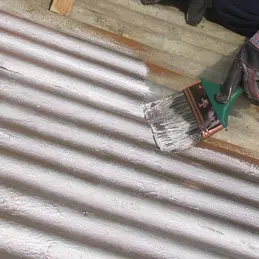
Watco Roofite Solar Reflective
A unique blend of bitumen, rubber and tough fibre reinforcement that instantly weatherproofs and refurbishes roofs and reflects heat. Ideal for performing repairs to split, cracked, holed and porous asbestos, corrugated iron, concrete, tiled and felted roofs. Part of the Roofite range - a range of products to repair, protect and waterproof...
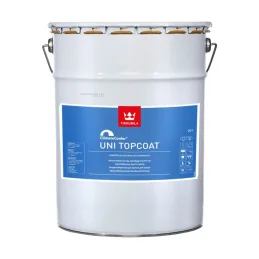
Tikkurila Climatecooler Uni Topcoat
ClimateCooler Uni Topcoat is a heat-reflecting water-borne modified acrylate paint, for painting of roofs and to be used as a system with ClimateCooler Uni Primer. Recommended uses include concrete tiles, fiber-cement sheets and primed steel sheet roofs Solar reflectance: Reflects up to 80% of heat radiation Best heat-reflectance result...
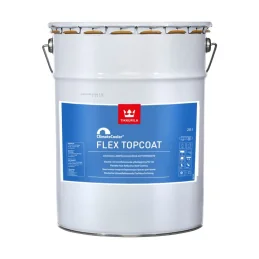
Tikkurila Climatecooler Flex Topcoat
Climatecooler Flex Topcoat , a flexible heat reflecting water-borne modified acrylate paint for the painting of roofs. To be used as a system with ClimateCooler Flex Primer. Recommended uses include bitumen and fiber cement roofings Can also be used for flat roofs with no standing water For industrial and professional use only More...
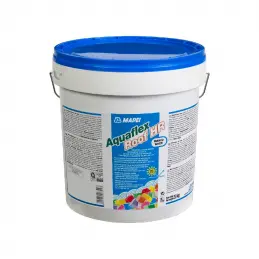
Mapei Aquaflex Roof HR
A fibre-filled liquid membrane in water emulsion with high solar reflectance and thermal emittance with a solar reflectance index (SRI) of 105. Protection against UV rays and heat for existing waterproof systems made from a distilled-bitumen/polymer membrane Protecting and waterproofing concrete surfaces, cementitious screeds, screeds...
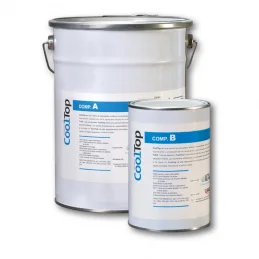
Eagle CoolTop
Eagle CoolTop is a white, reflective, two-component, aliphatic polyurethane resin that forms a continuous, flexible, shiny, protective film and prevents the absorption of solar radiation, so its application to building rooftops protects against the accumulation of structural heat. Holds up well against heavy foot and vehicle traffic....
Need Help?
Need Help?
Benefits of Using Solar Reflective Paints
Solar reflective paints provide multiple benefits for both residential and commercial applications:
Temperature Regulation: By reflecting sunlight, these paints drastically reduce the amount of heat absorbed by a building, resulting in cooler interior temperatures, especially during the summer months. This can lead to a noticeable difference in the comfort levels inside a building, making living or working conditions more pleasant.
Energy Efficiency: Lower indoor temperatures mean reduced reliance on air conditioning, leading to lower energy consumption and reduced utility bills. This is particularly beneficial in regions with high energy costs, where cooling a building can be a significant expense.
Extended Roof Lifespan: By minimising thermal expansion and contraction, solar reflective paints help prevent cracking, blistering, and other forms of damage, thereby extending the roof's lifespan. This not only saves money on repairs and replacements but also reduces the environmental impact associated with roof materials.
Leak Prevention: These coatings can enhance the waterproofing properties of roofs, thereby preventing leaks and moisture ingress. This is especially important in areas prone to heavy rainfall, where water damage can lead to costly repairs and structural issues.
Aesthetic Improvement: Available in a small selection of colours, these paints can improve the visual appeal of roofs while providing functional benefits. Whether you want a traditional white reflective surface or a metallic finish, there are options to suit different preferences.
Environmental Impact: Reduced energy consumption means lower greenhouse gas emissions, contributing to environmental conservation. By lowering the urban ‘heat island’ effect, these paints can also help reduce overall city temperatures, making urban environments more livable.
Typical Uses
Solar reflective paints are versatile and can be used in various settings, from residential homes to large industrial complexes. Their ability to reduce heat absorption makes them ideal for a wide range of applications.
DIY/Domestic Applications
- Residential Homes: Homeowners use these paints to reduce cooling costs and improve indoor comfort, particularly in attic spaces and rooms directly under the roof. In the UK, where summers can occasionally be quite warm, maintaining a cool home is essential for comfort and energy savings.
- Outbuildings: Structures such as garages, sheds, and summerhouses benefit from reduced heat buildup, making them more usable during hot weather. By keeping these spaces cooler, you can protect stored items from heat damage and create a more comfortable environment for hobbies and activities.
- Caravans and Mobile Homes: These coatings help maintain cooler interiors in mobile living spaces, enhancing comfort during travel. This is particularly important for those who enjoy holidaying in warmer climates or during the summer months in the UK.
Commercial and Industrial Applications
- Commercial Buildings: Office buildings, retail stores, and other commercial properties use reflective paints to lower energy costs and enhance occupant comfort. In highly populated areas, these savings can be substantial, contributing to a more sustainable business operation.
- Warehouses: Large storage facilities benefit from temperature regulation, protecting stored goods from heat damage and reducing cooling expenses. This is crucial for businesses that store temperature-sensitive products, as it helps maintain product quality and reduce spoilage.
- Factories: Industrial settings see reduced cooling costs and improved working conditions, which can boost productivity and worker satisfaction. By providing a more comfortable working environment, employers can enhance employee well-being and efficiency.
History of Solar Reflective Paints
The concept of solar reflective paints dates back several decades, originating as a response to the urban heat island effect—a phenomenon where urban or inner city/densely populated areas experience higher temperatures than their rural counterparts due to human activities and heat-absorbing materials. Initially, these paints were developed to mitigate intense heat in cities and improve energy efficiency. Over the years, advancements in materials science and technology have significantly enhanced their reflectivity, durability, and applicability, making them a viable option for a wide range of uses.
Early solar reflective coatings were rudimentary and primarily focused on reducing surface temperatures. However, with the advent of new technologies and materials, modern solar reflective paints offer improved performance, longer lifespan, and greater versatility. Today, they are an integral part of sustainable building practices, contributing to energy conservation and environmental protection.
Storage and Application
Proper storage and application of solar reflective paints are critical to achieving optimal performance and longevity. Understanding these aspects can help ensure that you get the most out of your investment.
Storage
Conditions: Store solar reflective paints in a cool, dry place away from direct sunlight. Exposure to extreme temperatures can compromise the paint's efficacy. Maintaining a stable storage environment ensures that the paint retains its properties and performs as expected.
Sealing: Ensure containers are tightly sealed to prevent contamination, evaporation, and drying out. Contaminated or dried-out paint can lead to poor application results and reduced effectiveness.
Application
Surface Preparation: Clean the surface thoroughly, removing dirt, debris, loose material, and any existing coatings that are peeling or damaged. A clean, dry surface ensures optimal adhesion and performance. Proper surface preparation is essential for achieving a smooth, durable finish.
Application Methods: Use a brush, roller, or spray equipment, depending on the size and complexity of the surface. Follow the manufacturer's instructions regarding the number of coats and drying times. Typically, two coats are recommended for optimal performance. Ensuring even coverage and following the recommended application techniques can help maximise the benefits of the paint.
Environmental Conditions: Apply in favourable weather conditions—ideally on a dry day with moderate temperatures. Avoid application in high humidity or extreme heat to ensure proper curing. Adhering to these conditions helps prevent issues such as bubbling, cracking, or incomplete curing.
Common Colour Options
White: Highly reflective and most effective for reducing heat buildup. White coatings are the most popular due to their superior reflectivity. They are particularly effective in hot climates but can also benefit buildings in temperate regions by reducing overall cooling needs.
Aluminium: Offers excellent reflective properties and is suitable for older, weathered roofs. The metallic finish also adds an aesthetic appeal. Aluminium coatings are often used on industrial buildings where a durable, high-performance coating is needed.
Suitable Substrates
Solar reflective paints can be applied to a variety of substrates, making them versatile for different building types and surfaces:
Concrete: Common in commercial and industrial buildings. Concrete roofs can benefit greatly from reflective coatings to reduce heat absorption and thermal stress.
Wood: Used in residential and some commercial structures. Wooden roofs and structures can be protected from heat damage, prolonging their lifespan and maintaining structural integrity.
Brick: Often seen in both residential and commercial applications. Reflective coatings on brick surfaces can enhance energy efficiency and reduce cooling costs.
Metal: Suitable for industrial buildings, warehouses, and metal roofing. Metal roofs can become extremely hot, and reflective coatings can significantly reduce this heat, improving indoor conditions and energy efficiency.
Bitumen: Common in flat roofs and older roofing systems. Bitumen roofs benefit from reflective coatings by reducing thermal expansion and contraction, preventing damage.
Felt: Used in certain residential and commercial roofing applications. Felt roofs can be protected from UV damage and heat degradation with the application of reflective coatings.
Building Regulations
Compliance with Building Standards
In the UK, building regulations are designed to ensure the health, safety, and welfare of people in and around buildings. While solar reflective paints are generally considered a building enhancement rather than a structural element, their application must still comply with certain building regulations, particularly regarding energy efficiency and fire safety.
Energy Efficiency: Solar reflective paints contribute to the energy efficiency of a building by reducing the need for air conditioning and lowering energy consumption. This aligns with the UK government's energy performance standards for buildings, which aim to reduce carbon emissions and promote sustainable construction practices. Although there is no specific regulation mandating the use of solar reflective paints, their use can help buildings achieve higher Energy Performance Certificate (EPC) ratings.
Fire Safety: Any material applied to the exterior of a building must meet fire safety standards as outlined in the building regulations. Solar reflective paints must be tested and certified for fire resistance to ensure they do not contribute to the spread of fire. This is particularly important for commercial buildings and high-rise residential properties where fire safety regulations are stringent.
Planning Permissions
Planning Permission Requirements
Generally, applying solar reflective paint to an existing building does not require planning permission, as it is considered maintenance or minor improvement. However, there are exceptions, particularly in designated areas or for listed buildings.
Conservation Areas: In conservation areas, where preserving the historic or architectural character is a priority, any external changes, including the application of solar reflective paint, may require planning permission. It is essential to consult the local planning authority before commencing any work.
Listed Buildings: For listed buildings, any alteration that affects the character of the building will require listed building consent. This includes applying solar reflective paint. Property owners must obtain consent from the local planning authority to ensure that the proposed changes are in keeping with the building's historic significance.
Article 4 Directions: In some areas, local authorities have issued Article 4 Directions, which remove certain permitted development rights. This means that even minor external alterations, such as applying solar reflective paint, may require planning permission. Always check with the local planning authority to determine if Article 4 Directions apply to your property.
Environmental Considerations
Environmental Impact and Sustainability
The UK government has set ambitious targets for reducing carbon emissions and promoting sustainability. Solar reflective paints play a role in these efforts by improving energy efficiency and reducing the demand for cooling in buildings.
Green Building Standards: Solar reflective paints can help buildings meet green building standards such as BREEAM (Building Research Establishment Environmental Assessment Method) and LEED (Leadership in Energy and Environmental Design). These standards encourage the use of sustainable materials and practices to minimise environmental impact.
Urban Heat Island Mitigation: Solar reflective paints contribute to reducing the urban heat island effect, where urban areas become significantly warmer than their rural surroundings. This is achieved by reflecting more sunlight and absorbing less heat, which can help lower overall temperatures in cities and reduce the strain on energy resources.
Incentives and Grants
Government Incentives and Support
To encourage the adoption of energy-efficient and sustainable building practices, the UK government offers various incentives and grants. While specific schemes for solar reflective paints may not be widespread, they can be part of broader energy efficiency improvement initiatives.
Green Homes Grant: Although the Green Homes Grant scheme has ended, similar future schemes may provide financial support for energy efficiency improvements, including the application of solar reflective paint. Homeowners should stay informed about new government initiatives.
Energy Company Obligation (ECO): The ECO scheme obligates energy suppliers to support energy efficiency measures for households. Solar reflective paints could be included as part of a package of improvements to reduce energy consumption and enhance building performance.
Best Practices and Recommendations
Ensuring Compliance and Maximising Benefits
To ensure compliance with UK laws and maximise the benefits of solar reflective paints, consider the following best practices:
Consult Professionals: Engage with building professionals, including architects and contractors, who are familiar with local regulations and best practices for applying solar reflective paint. They can provide valuable guidance and ensure that the project meets legal and safety standards.
Check Local Regulations: Always check with the local planning authority to determine if planning permission or other consents are required before applying solar reflective paint. This is especially important for properties in conservation areas or those subject to Article 4 Directions.
Choose Certified Products: Use solar reflective paints that are certified for fire resistance and environmental performance. Look for products that have been tested and approved by recognized certification bodies.
Regular Maintenance: Maintain the reflective coating according to the manufacturer's recommendations to ensure its long-term effectiveness and compliance with building regulations.
Technical FAQs
What is solar reflective paint?
Solar reflective paint, also known as cool roof coating, is a type of coating designed to reflect more sunlight and absorb less heat compared to standard roofing materials. This reduces the amount of heat transferred into a building, resulting in lower indoor temperatures and energy costs. These paints contain special pigments and additives that enhance their reflective properties.
How does solar reflective paint work?
Solar reflective paint contains special pigments and fillers that reflect sunlight and infrared radiation. By minimising the absorption of solar energy, the paint helps keep the roof surface cooler, reducing the heat load on the building. This is achieved through the use of reflective materials that bounce a significant portion of the sun's rays back into the atmosphere.
Can I apply solar reflective paint myself?
Yes, many solar reflective paints are designed for DIY application. However, it is crucial to prepare the surface properly, follow the manufacturer's instructions, and ensure even application to achieve the best results. Professional application may be preferred for larger or more complex surfaces to ensure optimal performance and longevity.
Is solar reflective paint suitable for all roof types?
Solar reflective paints are versatile and can be used on various roof types, including flat, pitched, metal, and bituminous roofs, as well as on flat roofs, sheds, and utility buildings. It is essential to choose the right product for the specific material of your roof to ensure compatibility and effectiveness. Consulting with a professional or the paint manufacturer can help determine the best product for your needs.
How long does solar reflective paint last?
The lifespan of solar reflective paint varies depending on the quality of the product and environmental conditions. On average, these coatings last between 5 to 10 years. Regular maintenance and reapplication as needed can extend their effectiveness. Factors such as exposure to harsh weather conditions, UV radiation, and physical wear can impact the longevity of the coating.
Can solar reflective paint prevent roof leaks?
While solar reflective paints are primarily designed to reflect heat, many also offer waterproofing properties that can help prevent roof leaks. However, they should not be relied upon as the sole solution for significant waterproofing needs. It is important to address any underlying issues with the roof structure and use additional waterproofing measures if necessary.
What are the environmental benefits of solar reflective paint?
By reducing the need for air conditioning, solar reflective paints lower energy consumption and greenhouse gas emissions. Additionally, cooler roofs contribute to mitigating the urban heat island effect, promoting a healthier and more sustainable environment. The use of reflective coatings can also reduce the demand on power grids during peak cooling periods, contributing to overall energy conservation.
Are there any misconceptions about solar reflective paints?
A common misconception is that solar reflective paints only work in hot climates. In reality, they can also provide benefits in cooler climates by stabilising indoor temperatures and reducing heating and cooling loads throughout the year. Another misconception is that all reflective paints are the same; in fact, different formulations offer varying levels of reflectivity and durability.
How do I maintain a roof coated with solar reflective paint?
Regular inspections and cleaning to remove dirt and debris will help maintain the paint's effectiveness. Reapply the coating as recommended by the manufacturer, typically every 5 to 10 years, to ensure ongoing performance. It is also important to repair any damage to the roof surface promptly to prevent deterioration of the coating.
What are the limitations of solar reflective paint?
Solar reflective paints may be less effective on roofs with heavy foot traffic or standing water. Proper application and regular maintenance are crucial for optimal performance. Additionally, they may not be suitable for roofs with severe damage or extensive leaks. In such cases, it is important to address structural issues before applying the coating.
Can solar reflective paint be used on walls?
Yes, some solar reflective paints are suitable for walls and other vertical surfaces. These coatings can help reduce heat absorption and improve indoor comfort in buildings with extensive sun exposure. Reflective coatings on walls can also contribute to overall energy efficiency and enhance the appearance of the building.
Is there a difference between water-based and solvent-based solar reflective paints?
Water-based solar reflective paints are generally easier to apply and clean up, making them ideal for DIY projects. Solvent-based paints, on the other hand, offer greater durability and weather resistance, making them suitable for more demanding applications. Each type has its own advantages and is chosen based on the specific requirements of the project.
What are the health and safety considerations when using solar reflective paint?
During application, it is important to use protective equipment such as gloves, masks, and goggles to avoid skin and respiratory irritation. Ensure adequate ventilation when applying solvent-based paints to prevent the buildup of fumes. Follow all safety guidelines provided by the manufacturer to protect yourself and others during the application process.
Does solar reflective paint affect the building's insulation?
Solar reflective paint does not affect the building's insulation directly. However, by reducing heat gain, it can complement existing insulation and improve overall energy efficiency. This can result in a more stable indoor temperature, reducing the need for additional heating or cooling.
Can solar reflective paint be tinted?
No, these specialist finishes cannot be tinted, as it will negatively affect the reflectivity of these paints, as different colours may be lower in reflectivity when compared to standard white or aluminium coatings.
Is professional installation recommended?
Professional installation ensures optimal coverage and performance, particularly for large or complex roofs. While DIY application is possible, professional expertise can help avoid common pitfalls and ensure the best results. Professional installers have the experience and equipment needed to apply the coating evenly and effectively.
Can solar reflective paint be applied over existing coatings?
Yes, solar reflective paint can be applied over existing coatings, provided they are in good condition and properly prepared. The surface should be clean, dry, and free from loose material to ensure proper adhesion. If the existing coating is damaged or deteriorating, it may need to be removed or repaired before applying the new paint.
What is the difference between solar reflective paint and regular paint?
Solar reflective paint contains special pigments and additives designed to reflect sunlight and reduce heat absorption. In contrast, regular paint lacks these reflective properties and is primarily focused on aesthetics and surface protection. Solar reflective paints are engineered for performance, offering both aesthetic and functional benefits.
Are there any building regulations for using solar reflective paint in the UK?
It is important to check local building regulations and guidelines when using solar reflective paint, especially for commercial properties. Compliance with these regulations ensures the safety and effectiveness of the application. Building codes may specify requirements for reflective coatings, particularly in urban areas where reducing heat islands is a priority.
What are the cost implications of using solar reflective paint?
While the initial cost of solar reflective paint may be higher than standard paint, the long-term energy savings and extended roof lifespan provide significant cost benefits. Reduced energy bills and maintenance costs can offset the initial investment over time. Additionally, some regions may offer incentives or rebates for using energy-efficient building materials, further reducing the overall cost.
What Rawlins’ Customers Say:
Don’t just take our Technical Support Teams’ words for it, here’s what our customers have to say about solar reflective paint they have purchased from our store:
The information provided above is a basic overview and is intended as general information only. It is not advice, and is given without warranty. You should always refer to the relevant data sheets and our Technical Team prior to purchase or use of any products.
